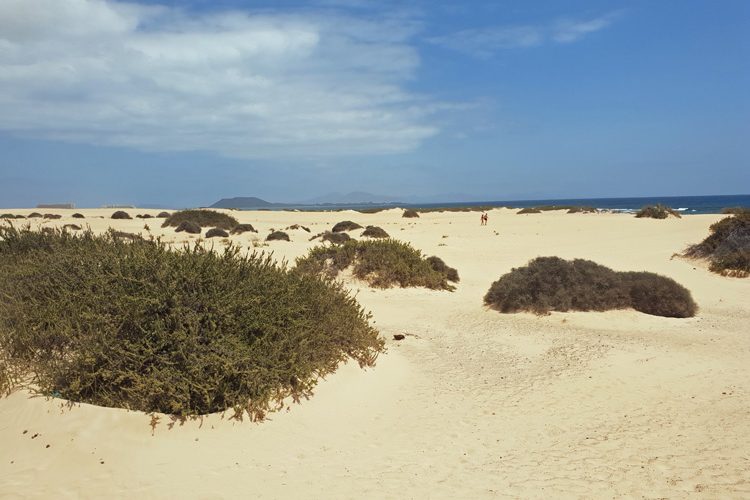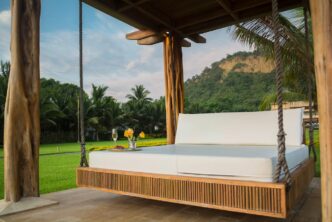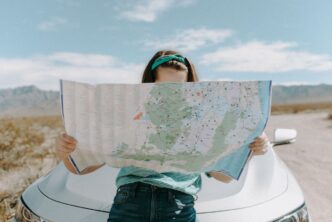Lorraine Worsley-Carter loses her hat and her heart to the windy, volcanic island of Fuerteventura.
Fuerteventura is about 20 million years old and is the oldest formation of all the Canary Islands. Who cares about that though when you are sunning yourself on one of the many brilliant white or black beaches or perhaps careering down the dunes towards the lagoons or flying your kite, and there is certainly enough wind for a good kite flight!
Fuerteventura means ‘Windy Island.’ And what a pleasure the breeze is when walking on one of those beautiful beaches that surround the volcanic island. I did, however, make the mistake of sporting my jaunty straw hat this year. In future, it will be back to my trusty cotton cap that stays firmly on my head – chasing my straw hat across parts of the island will at least have been good for my waistline! There is so much delicious food about which I describe as ‘Tapas meets Portuguese cuisine.’
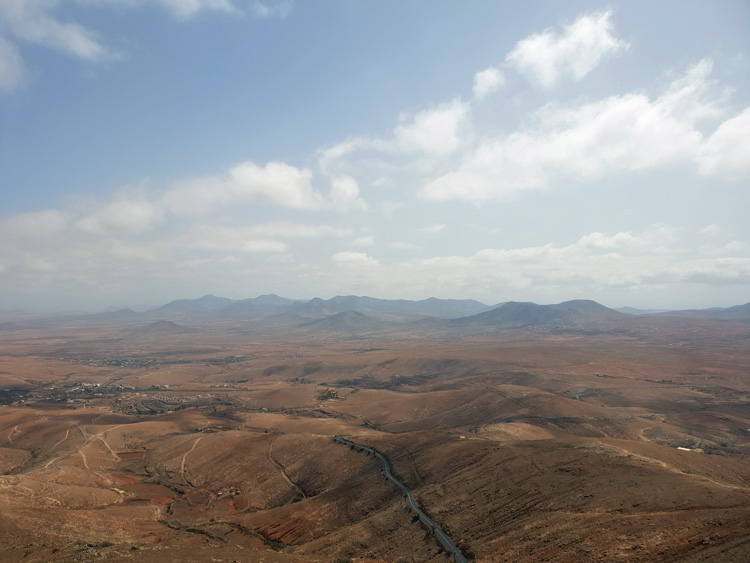
The economy of Fuerteventura is mainly based on tourism. Primary tourist areas are located around the existing towns of Corralejo in the north and Morro Jable in Jandia, plus the purely tourist development of Caleta de Fuste, south of Puerto del Rosario.
It is easy to think that Fuerteventura is all about beach holidays but there is much to see and experience inland too. Car driving is easy as there are very straight roads and apart from in the capital of Puerto del Rosario, it is possible, not to pass another vehicle for a few kilometres.
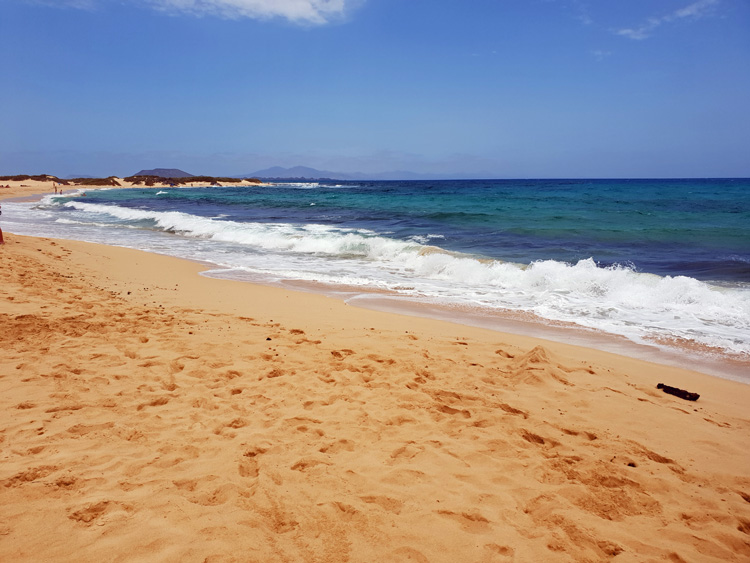
After a four-and-a-half hour flight from Manchester, one of our first stops is the sleepy village of Pajara. At its heart is the Nuestra Señora de Regla Church, dating back to 1687. The stone facade features Aztec-inspired designs of sun rays and animals.
I love the fact that the church is in darkness, however, if you look on the right-hand wall as you enter there is a chance for you to put a euro in a slot and voila! The whole church lights up!
My brother and his wife live on Fuerteventura. He is an artist and is often called upon to paint many of the island’s beauty spots, including Pajara. Not far from Pajara, in the middle of the island, is the town of Betancuria, a popular trek for walkers. The town was founded in the fifteenth century, by Jean de Betencourt, the conqueror of the island, and until 1834 it was the administrative capital of the island. It is located in the valley of the Massif Betancuria (Country Park) and is one of less desert-like areas of the island.
Betancuria town is the least populated municipality of Fuerteventura with around only 800 inhabitants, the town is of artistic and historical interest of the island. Among these points of interest is the fifteenth century ‘ Church of Santa Maria’. The original church was destroyed by pirates in the sixteenth century and rebuilt in the seventeenth century, and inside you can see various works of religious art.
The black beach of Poza Negro is a find, still unspoilt, with just a few fishermen’s houses. The waves can evoke strong rip tides and swimmers need to be vigilant and aware. There are less than a handful of beach bars, my favourite is Flipflops Beach Café where, if you can spare them, you can sign your old flipflops, leave them behind and they are nailed to the outside fence!
We always factor in a trip to Gran Tarajal, one of the biggest towns on the island and owes its success to the fact that tomatoes were once shipped from here. They are now mainly shipped from the main port in Puerto del Rosario. Still a non-touristic area, we love to sit outside at a a quay side café watching the fishermen prepare the fish on huge wooden boards, ready for the restauranteurs to collect the catches of the day. A highlight of the town centre is the beautiful fountain with six sea horses spouting water. This is situated right in middle of a shady oasis of tall palm trees just beside the church that was built in the 20th century. The construction of this church was financed by an emigrant returning from Cuba, who also introduced metal wind-wheels to the island.
Puerto del Rosario is a busy port and the capital of Fuerteventura, it’s known for its whitewashed houses and open-air artworks, including giant snail sculptures along the harbour promenade. I am told that there is much renovation and exciting redevelopment happening at the port and this will give me reason enough to revisit Fuerteventura before long.
On the southwest peninsula of Fuerteventura, Jandia is the place for the more demanding beach lover with its never-ending expanse of white sand.
Corralejo, a former fishing village, is dotted with eateries and bars. From here you can see Lobos Island , a nature reserve with rare birds and there is also a ferry from Corralejo to and from Lanzarote’s Playa Blanca leaves from here and many tourists book a day return trip.
Walking is growing in popularity throughout the island, and a series of marked paths are now being planned, which will enable walkers to trek from one end of the island to other – a week long walk of more than 155 kms ( 100 miles). The plains and hills are criss-crossed with ancient paths, so it’s best to walk with a guide if possible. There are several walking companies which offer guided walks through some of the most beautiful parts of the islands, from the dunes of Corralejo to the rugged high volcanic cliffs above the wild and beautiful Cofete beach in the south. It was here that the 2014 film ‘Exodus: Gods and Kings’ was shot, many of the local people were delighted to be film extras.
More recently, the same beach was used for some of the filming of ‘Wonder Woman 2.’ Cofete beach is wild and beautiful, voted one of the most beautiful top 10 beaches in Europe by Trip Advisor in 2015.
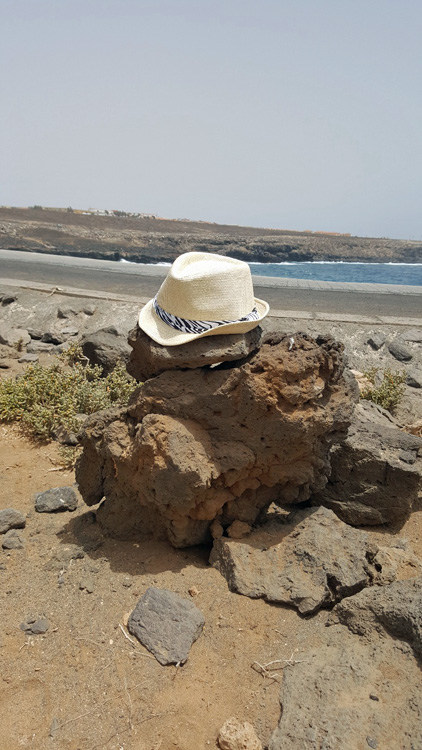
For the past couple of years local farmers have started to grow olives ready to convert to first grade olive all, first impressions are said to be good, so it looks like Fuerteventura will soon have another accolade to be proud off. I will lift my hat to that but it will not be my straw one!
Read about Liz Ratcliffe’s trip to the geothermal island of Lanzarote.

